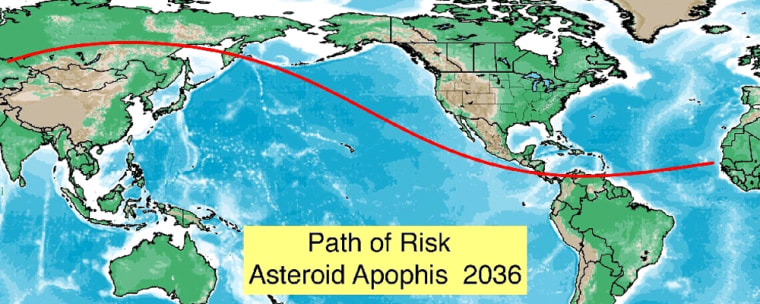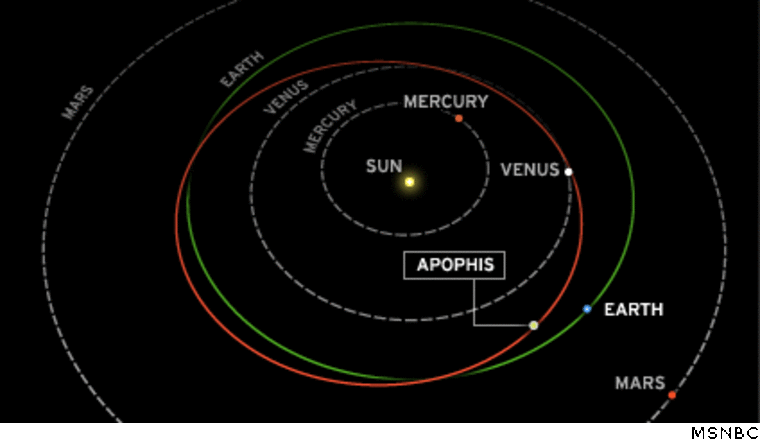After a fresh round of radar observations, astronomers said Thursday that the chances of a catastrophic asteroid impact in the year 2036 are lower than previously thought — and they're hoping the threat will be completely ruled out once more readings are made.
The chances of collision with the asteroid Apophis in 2036 now stand at 1 in 24,000, said Steve Chesley, an expert on near-Earth objects at NASA's Jet Propulsion Laboratory. That's a significant advance from the previous orbital predictions, which set the odds of impact at 1 out of about 6,000.
Chesley told MSNBC.com that there's still a slim chance of catastrophe, due to the remaining uncertainties about Apophis' orbital path, but "things are moving in the right direction."
Apophis, also known as 2004 MN4, was detected in 2004 and has been a source of concern since late that year. Astronomers estimate its diameter at about 1,300 feet (400 meters) — which means a collision would spark a regional catastrophe, though not a global extinction event on the scale of the dinosaurs' demise.
A strike in the Pacific Ocean would set off a "cosmic Katrina" capable of doing an estimated $400 billion worth of damage, according to the B612 Foundation. For that reason, astronomers are keen to reduce the projected risk to zero if they can — and devise a mission to divert the space rock if they can't.
Apophis is a special case because it spends most of its time within Earth's orbit, making observations difficult. The May 6-7 window for radar observations represented the best opportunity until the end of 2012. Jon Giorgini, a senior analyst for the Solar Systems Dynamics Group at JPL, said the Arecibo team got a good fix on Apophis.
"We were able to improve our understanding of its motion by about 6 millimeters per second," Giorgini.
Those readings underwent analysis for more than a week, and on Thursday, the researchers felt confident enough to share the results.
Will it hit the 'keyhole'?
The key calculations actually have to do with an encounter with Earth in the year 2029. If Apophis passes through a well-defined area of space no wider than a half-mile (1 kilometer), known as a "keyhole," the gravitational deflection will put the rock on a course to hit Earth seven years later. "You go through that little hole, and you're going to hit the earth," Chesley explained.
The uncertainty has to do with whether Apophis' path will take it through the keyhole in 2029. Although this month's observations reduced its chances of hitting the keyhole, there's still a margin of error that needs to be accounted for.
Asteroid-watchers have emphasized that there's nothing to worry about yet. In fact, Apophis appears to be following the pattern set by previous asteroid alerts, Chesley said.
"We've seen this happen very often," he said, "where [the perceived risk] rises to some level and starts to steady, then drops off. ... It goes up, and then it goes down. We're very much on a steady downward trend."
More chances for observations
Previously, NASA had said that no more observations could be made until 2013. But on Thursday, Chesley said more may be known before then. "Actually, we're going to probably get some observations, though they'll be difficult to obtain — maybe by next spring," he said. Astronomers at the Mauna Kea Observatory in Hawaii could spot the asteroid in 2007 as well as in 2011, he said.
In the 2012-2013 time frame, Arecibo could come into play again. Giorgini said those observations would be even more accurate because Apophis would come within 8.3 million miles (13 million kilometers) of Earth — much closer than this month's pass at a distance of 26 million miles (42 million kilometers).

If Apophis is still perceived to pose a threat after the 2013 observations, NASA has said it would draw up plans for missions to monitor the asteroid even more closely and divert it if necessary.
Asteroid alerts have been on the rise over the past decade, due to the greatly improved capability for detection of near-Earth objects. Chesley said "we're likely to see more" alerts as NASA and other agencies watch the skies more vigilantly.
"But I have to say my sense is that Apophis is absolutely extraordinary — a once-in-a-lifetime event," Chesley added. "I hope we don't have any more cases like this one. This is going to be memorable."
